Brattle Street Church
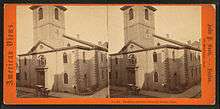
The Brattle Street Church (1698-1876) was a Congregational (1698-ca.1805) and Unitarian (ca.1805-1876) church on Brattle Street in Boston, Massachusetts.
Brief history
In January 1698, "Thomas Brattle conveyed the land on which the meeting-house was to stand; and on the 10th of May, 1699, a formal invitation was extended to Benjamin Colman... to be its minister." To distinguish itself in contrast to Boston's three other Congregational churches, the new fourth church issued a manifesto that detailed a somewhat relaxed attitude toward rigid Calvinist practices.[1][2] Thomas Brattle probably designed the unpainted, wood, meetinghouse-style building for the church, erected in 1699.[3] The building had a "main entrance in the bell tower (while retaining a secondary entrance on the long side) and ...[a] pulpit at the opposite end ...[and] rounded or compass windows."[4]
Through the years, ministers included: Benjamin Colman (1699-1747); William Cooper (1716-1743); Samuel Cooper (1747-1783); Peter Thacher (1785-1802); Joseph Stevens Buckminster (1805-1812); Edward Everett (1814-1815); John Gorham Palfrey (1818-1831); and Samuel Kirkland Lothrop (1834-1876).[5][6] Hans Gram played organ in the late 18th century. Parishioners included John Hancock, Samuel Adams, Joseph Warren, John Adams, Abigail Adams, Richard Clarke, Elizabeth Greenleaf, Jane Mecom, John Lowell, Lydia Hancock, Henry Cabot Lodge, James Bowdoin (1676-1747), and many others.[1][7] "Cato, favorite servant of the [John] Hancocks... received his freedom at age thirty, married, and baptized his children at the prestigious Brattle Street Church, all the while continuing to serve the town's leading family."[8]
In 1717 and 1724, the church hosted "the first singing school in Boston."[9] The wood church building of 1699 was replaced in 1772 with a brick structure, designed by Thomas Dawes. (John Singleton Copley had also submitted a design proposal, but Dawes' plan won.). For the new building, John Hancock "gave a thousand pounds, and a bell."[10][11][12][13] Around 1778, William Billings ran a "highly praised singing school" at the church.[14]
Henry Cabot Lodge, a parishioner in his youth, noted: "It was a fine old eighteenth-century church with a square tower, in which was embedded a cannon-ball said to have been fired and lodged there by the American batteries at the siege of Boston. The interior was in the classical style of Wren, much in vogue in the province in the days of Anne and the first Georges. A huge mahogany pulpit, the gift of John Hancock, towered up darkly in the center of what would have been called the chancel in any other than a Puritan church."[15]
In 1872, the Brattle Street church building was demolished. Work on a new church building in Back Bay began in 1873.[16] Designed by architect Henry Hobson Richardson, it opened in 1875, and is known as the Brattle Square Church. The church "became extinct in 1876."[17] The church building was sold in 1882 to the First Baptist congregation.[18]
At various times in its history, the Brattle St. Church was also known as:
- The Brattle Square Church
- The Brattle Street Congregational Church
- The Brattle Street Meeting House
- The Church and Society in Brattle Street[19]
- The Church in Brattle Square
- The Manifesto Church
- The Religious Society in Brattle Street[20][21]
- The Society in Brattle Street[22]
References
- 1 2 Benevolent Fraternity of Churches. The Manifesto Church: Records of the Church in Brattle Square, Boston, with Lists of Communicants, Baptisms, Marriages and Funerals, 1699-1872. 1902; p.vii-viii.
- ↑ A manifesto or declaration, set forth by the undertakers of the new church now erected in Boston in New-England, November 17th, 1699. Boston, 1699. Included in: Lothrop. A history of the church in Brattle street, Boston. 1851; p.20-26.
- ↑ Rick Kennedy. Thomas Brattle, Mathematician-Architect in the Transition of the New England Mind, 1690-1700. Winterthur Portfolio, Vol. 24, No. 4 (Winter, 1989), pp. 231-245. Includes illustration of the church.
- ↑ Kevin M. Sweeney. Meetinghouses, Town Houses, and Churches: Changing Perceptions of Sacred and Secular Space in Southern New England, 1720-1850. Winterthur Portfolio, Vol. 28, No. 1 (Spring, 1993), pp. 59-93.
- ↑ Andover-Harvard Theological Library, Harvard Divinity School. Church in Brattle Square (Boston, Mass.) Records (bMS 1): Register.
- ↑ "Boston Pulpit". Gleasons Pictorial. Boston, Mass. 5. 1853.
- ↑ Charles W. Akers. Religion and the American Revolution: Samuel Cooper and the Brattle Street Church. The William and Mary Quarterly, Third Series, Vol. 35, No. 3 (Jul., 1978), pp. 477-498.
- ↑ Charles W. Akers. "Our Modern Egyptians": Phillis Wheatley and the Whig Campaign Against Slavery in Revolutionary Boston. The Journal of Negro History, Vol. 60, No. 3 (Jul., 1975), pp. 397-410.
- ↑ Joseph Green, "A letter for the Rev'd Mr. Stephen Williams, Pastor of ye Church of Christ at Longmeadow in Springfield, dated Boston, Oct. 1, 1722," Transactions, Publications the Colonial Massachusetts 46 (1973): 391-92. Cited in: Gillian B. Anderson. "Samuel the Priest Gave Up the Ghost" and the Temple of Minerva: Two Broadsides. Notes (Music Library Association ), Second Series, Vol. 31, No. 3 (Mar., 1975), pp. 493-516.
- ↑ Samuel Adams Drake. Old landmarks and historic personages of Boston, rev. ed. James R. Osgood and Co., 1873; p.122.
- ↑ Frederic C. Detwiller. Thomas Dawes: Boston's Patriot Architect. Old-Time New England no. 249, Summer-Fall 1977.
- ↑ Frederic C. Detwiller. Thomas Dawes's Church in Brattle Square. Old-Time New England, Winter-Spring 1979.
- ↑ Illustration of church interior: Church in Brattle Square (Boston, Massachusetts): Andover-Harvard Theological Library
- ↑ Gillian B. Anderson. "Samuel the Priest Gave Up the Ghost" and the Temple of Minerva: Two Broadsides. Notes (Music Library Association ), Second Series, Vol. 31, No. 3 (Mar., 1975), pp. 493-516.
- ↑ Lodge, Henry Cabot (1913). Early Memories. Charles Scribner's Sons. p. 105.
- ↑ Order of exercises at the dedication of the new house of worship: erected by the proprietors of the Church in Brattle Square, corner of Commonwealth Avenue and Clarendon St., Monday, December 22d, 1873 ... Boston: Alfred Mudge & Son, printers, 1873.
- ↑ Harvard University. Church in Brattle Square (Boston, Mass.) Records (bMS 1): Register
- ↑ First Baptist Church of Boston
- ↑ Peter Thacher. A sermon preached to the Church and Society in Brattle-Street, Boston, Dec. 29, 1799 : and occasioned by the completion of a century from its first establishment. Boston: Printed by Young & Minns, 1800.
- ↑ Joseph Willard. A thanksgiving sermon delivered at Boston December 11, 1783, to the Religious Society in Brattle Street. Boston, Printed by T. and J. Fleet, 1784.
- ↑ David Tappan. A discourse, delivered to the Religious Society in Brattle Street, Boston, and to the Christian Congregation in Charlestown, on April 5, 1798. being the day of the annual fast in the Commonwealth of Massachusetts. Boston, S. Hall, 1798.
- ↑ Peter Thacher. A sermon preached to the society in Brattle Street, Boston, November 14, 1790, and occasioned by the death of the Hon. James Bowdoin, Esq. L.L.D., lately governor of the Commonwealth of Massachusetts. Boston: Printed by I. Thomas and E.T. Andrews, 1791.
Further reading
| Wikimedia Commons has media related to Brattle Street Church. |
- Samuel Kirkland Lothrop. A history of the church in Brattle street, Boston. W. Crosby and H. P. Nichols, 1851.
Images
-
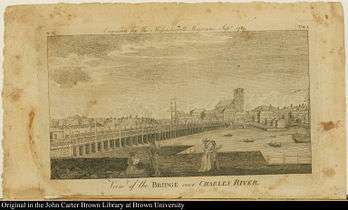
View of Brattle St. Church and Boston's West End, looking from across the Charles River in Cambridge, 1789
-
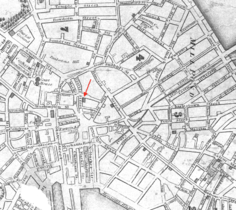
Detail of 1829 map of Boston, showing location of Brattle St. Church
-
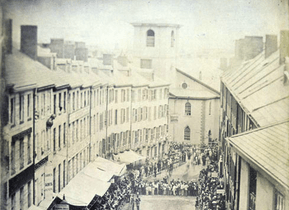
View of Brattle St. and church, 1855 (Bostonian Society)
-
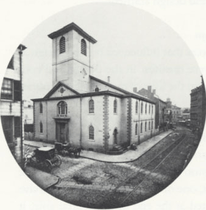
Brattle St. Church, Boston, 1859. Photo by J.J. Hawes
-

Interior, Brattle St. Church, Boston, ca.1860s
Coordinates: 42°21′37.08″N 71°3′28.44″W / 42.3603000°N 71.0579000°W